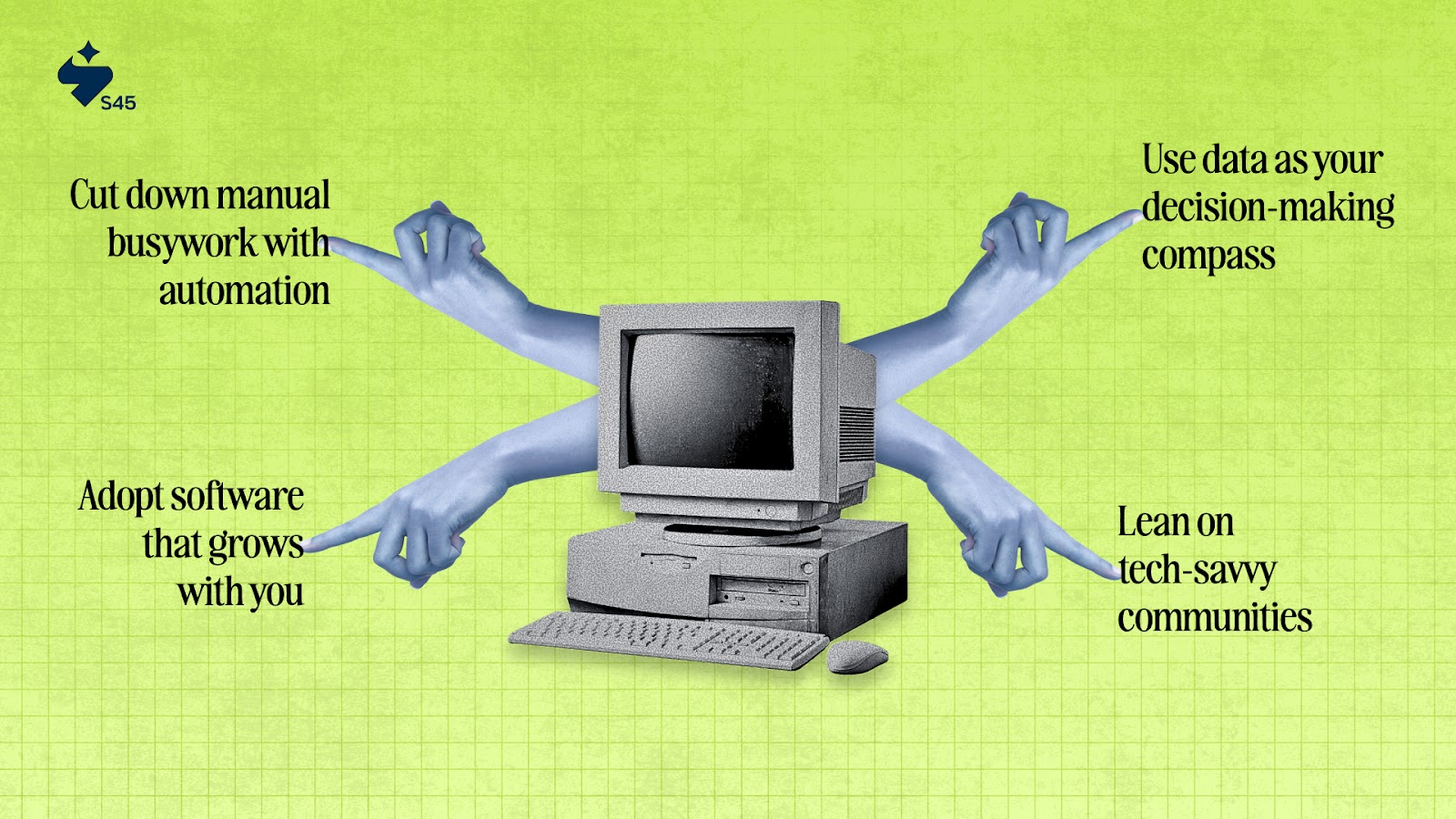
The contribution of India’s Micro, Small, and Medium Enterprises (MSMEs) to the country’s Gross Value Added (GVA) has steadily grown, rising from 27.3% in FY2020-21 to 29.6% in FY2021-22, and reaching 30.1% in FY2022-23, underscoring their increasing importance in the nation’s economy.
However, most SMEs and MSMEs still face shortages of skilled manpower, while many struggle with operational challenges and limited funding. These obstacles often restrict growth and impact the founder’s ability to build a sustainable business.
Knowing how to drive SME growth effectively is essential to overcoming these barriers. It requires a focused approach to planning, adopting technology, strengthening customer relationships, and managing finances. This blog covers practical strategies to help your SME grow sustainably, maintain control, and create lasting value.
Key Takeaways:
- SMEs significantly contribute to India’s GDP and job creation, making them crucial to the country’s economic stability.
- Many SMEs face barriers such as limited access to finance, outdated systems, and workforce skill gaps that hinder growth.
- A well-defined strategy with measurable goals helps direct resources effectively and sustain momentum.
- Using technology improves operational efficiency, enhances customer engagement, and expands market presence.
- Building long-term customer relationships through value-driven services increases loyalty and repeat business.
- Strong financial management and cost control protect against cash flow issues and market fluctuations.
- Strategic partnerships open opportunities for new markets, collaborative innovations, and shared resources.
Boost Your SME Growth Using Technology

For most SMEs, technology is all about solving everyday pain points: slow operations, manual errors, and limited visibility into what’s actually driving growth. Founders who adopt the right tools early often scale faster, manage costs better, and keep tighter control of their business.
Here are practical ways technology can directly support your SME growth:
- Cut down manual busywork with automation. Think about how much time your team spends on tasks like invoicing, stock updates, or sending reminders. Tools like Zoho Books (for invoicing) or TallyPrime (for accounting and GST compliance) automate these repetitive jobs. The result? Fewer errors, faster payments, and more time for strategic work like building new markets.
- Use data as your decision-making compass. Instead of guessing which product line will sell, use analytics to see what’s working. For example, even free tools like Google Analytics or low-cost CRMs such as HubSpot Starter can show customer buying patterns and sales cycles. According to NASSCOM, SMEs that use analytics see up to 20% higher revenue growth compared to those relying on gut instinct.
- Adopt software that grows with you. Many SMEs get stuck because the systems they start with can’t scale. Choosing cloud-based solutions (like AWS for hosting or Freshworks for customer support) means you can add features as your business expands—without ripping everything out and starting over. This reduces costly downtime and keeps your growth smooth.
- Lean on tech-savvy communities. You don’t need to figure it all out alone. Communities like S45club, India SME Forum, or local startup networks share best practices, tool recommendations, and case studies. Learning from other founders helps you avoid costly trial and error.
Using technology effectively is a crucial aspect of driving SME growth in today’s market. By streamlining operations, automating routine tasks, and making informed decisions based on data, you establish a stronger foundation while maintaining control. This balanced approach enables your SME to grow steadily, efficiently, and with lasting impact.
Here’s a Founder insight: Technology is a control mechanism. The more visibility you have into cash flow, customer behavior, and operations, the less dependent you are on external guesswork. That’s the real advantage in competitive markets.
Grow Your SMEs by Keeping The Customers Happy
For most SMEs, growth doesn’t come from pouring money into marketing; it comes from keeping existing customers loyal. Studies show it costs 5–7x more to acquire a new customer than to retain one, and loyal customers often spend more over time. For founders, this means one thing: a customer-first approach is the fastest, most affordable growth lever.
Here’s how to put it into practice:
- Solve real problems, not just sell products. Customers don’t stick with you for features—they stick because you make their lives easier. For example, a local packaging SME that offered customized eco-friendly options saw repeat orders surge because it directly addressed its clients’ sustainability concerns. When customers feel understood, they naturally become advocates.
- Personalize every interaction. Even small touches—like using a CRM tool (Zoho CRM, Salesforce Essentials) to track purchase history—help you tailor recommendations and offers. In retail SMEs, personalized offers have been shown to increase sales conversion by up to 30%. For founders, this is proof that personalization isn’t “extra”—it’s a revenue strategy.
- Listen actively and act fast. Whether through WhatsApp chats, online reviews, or in-store feedback, customers constantly tell you what’s working (and what isn’t). SMEs that respond within 24 hours to queries or complaints see much higher retention rates. It signals responsiveness and builds trust.
- Invest in your frontline team. Employees often shape customer perception more than founders do. A trained sales rep who can resolve queries quickly becomes a walking brand ambassador. Regular training—even short roleplay sessions—pays back in loyalty and referrals.
- Stay top of mind with useful content. Don’t only show up when you’re selling. Share “how-to” tips, product care guides, or exclusive loyalty deals through email or social media. This builds a sense of community around your brand and makes customers feel valued beyond the transaction.
Here’s another Founder insight: Happy customers aren’t just repeat buyers. They’re free marketers. Every retained customer lowers your acquisition cost, strengthens your margins, and makes your growth more predictable.
Drive Your SME Growth with Strong Finances

For many SME founders, finance is where growth either accelerates or stalls. Cash flow crunches, rising costs, or the wrong funding choices can undo years of hard work. Strong financial management isn’t just about bookkeeping; it’s about giving your business the stability to grow without losing control.
Here’s how to build that solid base:
- Plan your budget like a growth roadmap. Instead of treating budgeting as an annual exercise, break it into quarterly milestones linked to goals—like hiring, product launches, or market expansion. SMEs that review budgets quarterly are 30% more likely to meet growth targets (ICICI Bank SME survey). This ensures every rupee works toward your vision.
- Look beyond traditional loans. Many SMEs depend only on bank loans, but that often comes with rigid repayment pressure. Explore options like SIDBI schemes, CGTMSE guarantees, equity investors, or crowdfunding platforms. The right mix protects cash flow and gives you breathing space to expand without drowning in debt.
- Keep a tight grip on costs. Small leaks drain big ships. Using tools like TallyPrime, Zoho Books, or QuickBooks helps you track expenses in real time and flag unnecessary spending. Some SMEs save 10–15% annually just by identifying unused software subscriptions or renegotiating supplier contracts.
- Stay disciplined with cash flow. Late payments are one of the biggest founder frustrations. Simple fixes like automated invoicing, offering early-payment discounts, or negotiating staggered supplier terms can keep money moving. Think of cash flow as your oxygen—without it, growth suffocates no matter how good your product is.
- Let data guide your investments. Not every opportunity deserves your money. Use financial analysis to rank initiatives by ROI. For example, an SME founder in Pune found that investing in digital ads gave better returns than opening a
With clear budgeting, smart funding choices, vigilant cost control, and careful cash flow management, your business stays resilient and ready to seize growth opportunities. If you need detailed information on these strategies, talk to S45club for a quick result from the top founders and investors. This disciplined approach helps build a sustainable future with lasting impact.
Here’s a Founder insight: A strong financial base gives you the confidence to take bold bets. When your cash flow is stable and your costs are under control, you can invest in growth without losing sleep.
Increase Your SME Growth by Partnering With Others
For many founders, growth stalls not because of a lack of ambition, but because of limits like capital, distribution, expertise, or bandwidth. Partnerships help break these ceilings without diluting ownership or overstretching resources.
Here’s how smart collaborations can accelerate your next stage of growth:
- Expand reach without burning cash. Partner with businesses that complement yours, like a logistics startup teaming with a D2C brand. You instantly access each other’s customer base and expertise without doubling your marketing spend.
- Cut costs through shared resources. Warehousing, distribution fleets, and even marketing campaigns, splitting these costs with trusted partners reduces overhead and frees up cash flow for reinvestment.
- Strengthen your market presence through co-branding. Joint events, bundled offerings, or industry reports create stronger recall and trust. Customers see you as part of a larger, credible ecosystem instead of a small, standalone player.
- Enter new markets with less risk. Expanding into a new city or country? Partnering with a local SME gives you cultural insights, regulatory shortcuts, and built-in networks, advantages that take years to build on your own.
- Unlock opportunities through founder communities. Active participation in industry and founder networks like S45club often leads to unexpected deals, distribution tie-ups, vendor discounts, and even investor introductions. The more visible and helpful you are, the more opportunities circle back to you.
Strategic partnerships bring in fresh capabilities, extend your reach, and provide mutual support in a competitive market. By choosing collaborators who align with your values and growth vision, you can scale faster while safeguarding your business's long-term sustainability.
Simple Steps to Drive SME Growth by Planning Smartly
Effective planning is key when it comes to understanding how to drive SME growth. When your business goals align with your vision, every step you take moves you closer to building a lasting legacy. A clear plan based on real market insights helps you grow steadily, without losing control or compromising quality.
Step 1: Set clear, specific goals that reflect your company’s vision and legacy. Establish measurable targets like revenue milestones, market share growth, or customer acquisition numbers. These goals give your team clear direction and make it easier to track progress.
Step 2: Conduct thorough market research to understand customer needs and emerging trends. Gather feedback through surveys, customer conversations, and competitor analysis to identify gaps your SME can fill. Staying aware of market shifts helps you adapt your offerings and stay competitive.
Step 3: Break down your vision into actionable steps with measurable milestones. Develop a timeline with quarterly or monthly checkpoints for sales, product development, or operational goals. This keeps your growth on track and allows timely adjustments.
Step 4: Prioritize growth initiatives that deliver strong returns while managing resources wisely. Focus on high-impact activities that optimize cash flow and resource use, like refining your sales process or automating routine tasks, rather than spreading yourself too thin.
Step 5: Regularly review progress and adjust plans to fit changing business conditions. Schedule monthly or quarterly reviews to evaluate what’s working and what isn’t, updating your strategy based on data and feedback. Being flexible ensures sustainable growth despite market fluctuations.
Clear goals, a deep understanding of your market, and a straightforward, actionable plan give you the control and confidence to grow steadily. This approach lays a strong foundation for sustainable growth and a meaningful legacy.
Final Thoughts Before We Wrap Up
Scaling through SME exchange platforms isn’t just about raising capital—it’s about building sustainable, capital-efficient growth. Communities like S45club help founders tap into collective expertise, investor confidence, and mentorship for navigating complex listing decisions.
Beyond funding, partnerships play a powerful role in accelerating growth. Collaborating with complementary businesses opens new markets, co-branding builds credibility, and resource sharing reduces costs. Leveraging networks provides faster entry into new regions while founder communities spark fresh opportunities. With the right ecosystem of peers, investors, and collaborators, SMBs can grow responsibly, expand reach, and position themselves for long-term success.
Frequently Asked Questions
1. What are the biggest challenges Indian SMEs face in scaling operations?
SMEs often struggle with limited funding options, outdated operational systems, and a shortage of skilled talent. These factors create bottlenecks in production, customer acquisition, and market expansion, making strategic planning and targeted investments essential for scaling.
2. How can SMEs use technology to improve profitability?
Implementing affordable digital tools such as cloud-based accounting, CRM software, and e-commerce platforms can reduce manual workload, cut operational costs, and improve customer data management. This helps SMEs make quicker, data-backed decisions that directly boost profitability.
3. Why is customer retention more important than acquisition for SMEs?
Acquiring a new customer can cost five to seven times more than retaining an existing one. SMEs that focus on improving customer service, offering loyalty programs, and maintaining consistent quality often see better long-term revenue stability.
4. What financial practices help SMEs avoid cash flow issues?
Maintaining a rolling cash flow forecast, separating business and personal expenses, and negotiating favorable payment terms with suppliers can protect SMEs from liquidity crises. Timely invoicing and effective receivables tracking also prevent revenue delays.
5. How do strategic partnerships benefit SMEs in competitive markets?
Collaborating with other businesses can provide access to shared marketing channels, joint product development, and expanded distribution networks. For SMEs, these alliances often reduce operational risks while accelerating market penetration.


